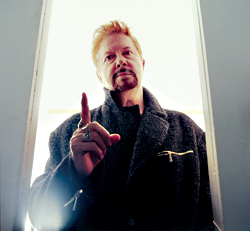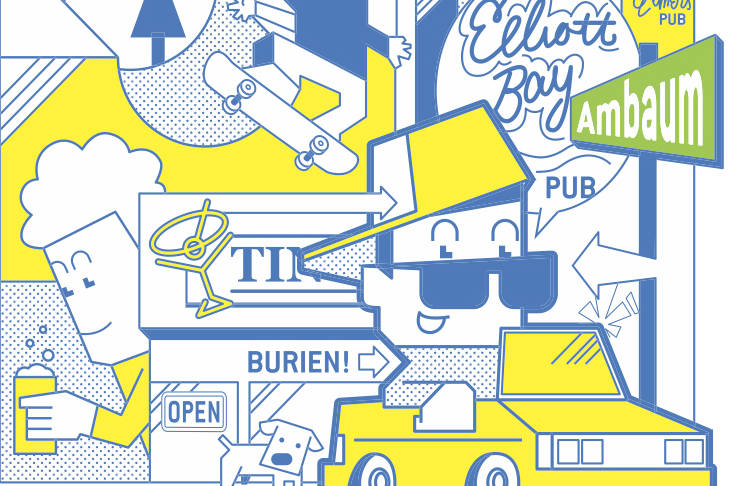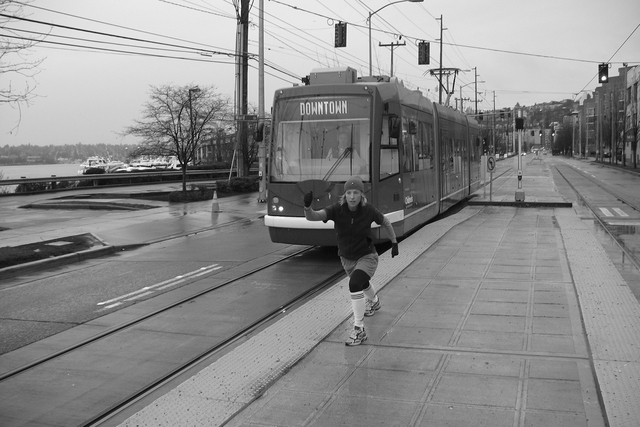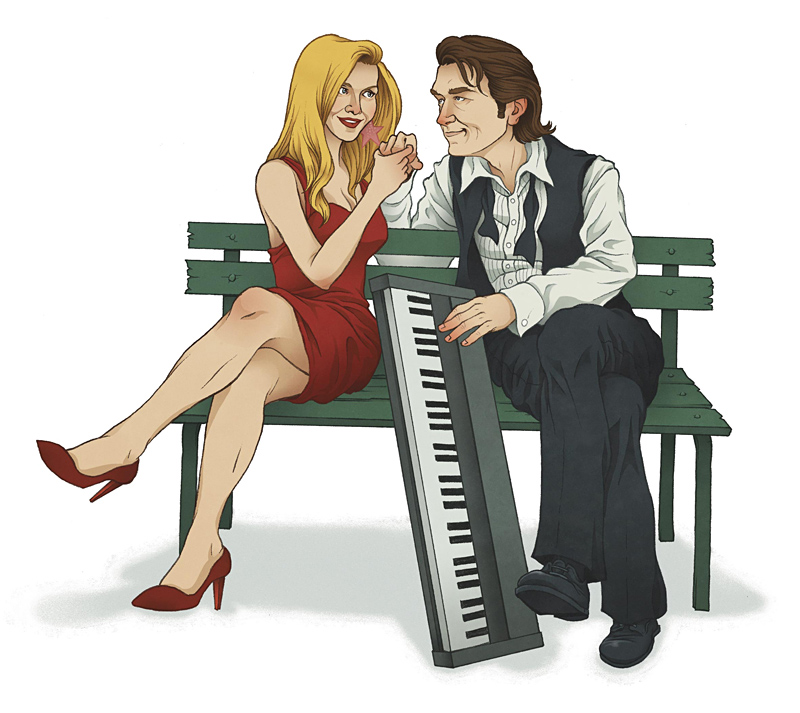Fifty-two degrees and drizzly is quintessential Thursday morning weather for Tom Robbins, perhaps the region’s most famous raindrop booster. Clad in green rubber sandals and a white linen suit, the goateed novelist opens the front door of his hillside LaConner home to reveal a yappy little dog and a wall-length living-room tapestry featuring a cartoon bikini babe toying with a lion. Wearing dark wraparound shades owing to recent eye surgery intended to right the wrongs of a 25-year-old tennis boo-boo, Robbins, for the first time since primary school, has been on a forced sabbatical from writing, which has afforded him time to half-seriously ponder life after literature.
“It’s been interesting to see what it’s like not to write,” he says. “There are characters walking through my cranium, making a lot of fuss. But maybe it’s time to move on. I’ve always wanted to be an international jewel thief, but I’m not that dexterous, so I think I’d fail miserably.”
His pint-sized pooch along for the ride, Robbins strolls into his kitchen, which contains a red-and-white checkerboard linoleum floor and Warholian pop art on its walls. Resting on the counter is a fairly current portrait of Robbins hanging out under the Blue Moon Tavern’s crescent awning. Of this, the novelist says: “That picture contains two of my favorite things about Seattle: rainy weather and the Blue Moon.”
Ever since he moved to LaConner full time in 1970, Robbins’ trips to the Blue Moon have decreased in frequency. He still makes it by whenever he’s in town; not a calendar year has passed where he hasn’t wandered in for some cold draft beer and back-booth chatter.
“It’s changed,” says Robbins of the 72-year-old U District tavern. “I felt like when they put in the pool table, it was a step in the wrong direction, because it took the focus away from drinking and conversation. And yet enough of what it was like in ’62 has remained the same. The moment you walk in the door, you know it’s the Blue Moon.”
Between 1962 and 1969, Robbins, amidst daily gigs with both The Seattle Times and Seattle Post-Intelligencer, was a devout Blue Moon regular (he spent ’69 holed up with his girlfriend in an $8-a-month apartment in the dank Highway 101 town of South Bend, drafting his debut novel, Another Roadside Attraction).
“On Wednesday nights, I wrote my art column for the Sunday edition,” recalls Robbins. “I’d usually finish at midnight and go to the Moon. I’d go there other nights, of course, but this was my ritual. There was a great cast of characters there. In those days, the Blue Moon was a place to have drinks and discussion, the occasional fistfight, and various bouts of lewdity and levity. [The poet] John Pym would slowly disrobe throughout the night, and eventually you realized he’d be sitting there nude.”
Then there’s the oft-manipulated story about how Robbins, on a bet, called Pablo Picasso from a pay phone near the Moon’s entrance.
“I was working as an art critic, and somehow I’d gotten what was supposedly Picasso’s home phone number,” Robbins says. “I gave the overseas operator his number and called collect. The call went through, someone answered, there were a few words in French, and then they hung up. I like to believe it was him, standing there in a petticoat, but it was probably a servant.”
Even before Robbins first set foot in the Moon, he’d become infatuated with the place through word of mouth while living in Virginia.
“There was a network of bohemian taverns, and in most cities, there was a bar where beatniks could go and find like-minded people,” says Robbins. “In Richmond, it was the Village; in New Orleans, it was the Seven Seas; in New York, it was the Cedar Tavern; and in Seattle, it was the Moon. So when I moved here in ’62, that’s the first place I went. It’s a proletariat and intellectual bar—you get pipe fitters and carpenters mingling with grad students and painters. This sort of interchange is healthy. There is a combination of funkiness and earthiness, with a great deal of intellectual and artistic ferment. Seattle has never had a lot of soul, and the Moon is one of the most soulful places in the city.”
Yet every decade or so, the powers that be seem intent on ripping it out, says Robbins, who was actively involved in the successful early-’90s campaign to spare the Moon from a developer’s wrecking ball.
“For more than 30 years, the Seattle establishment complained that the Blue Moon was a haven for communist activity,” he says, beginning a three-tiered historical analogy. “Now there were communists there, but they didn’t rip apart the moral fabric of the city—and in time, they went away.”
“In the ’60s and ’70s, the city complained that the Moon was a haven for war protesters,” he continues. “There were antiwar protesters there, but they didn’t damage the moral fiber of the city—and eventually they went away.
“Now, the city is complaining that the Moon is a haven for drug dealers, but they aren’t tearing apart the moral fabric of the city—and eventually they’ll go away.”
“The Blue Moon is a cultural treasure,” concludes Robbins. “And the mayor and his staff should know they’ll be destroying a cultural treasure as well as depleting the city’s soul. The political establishment operates on two principles: fear and greed. Even in a city the size of Seattle, one little bit of free-flowing plankton in this ocean of urbanity is enough to scare them. Most people are afraid of freedom, and the Blue Moon is a bastion of freedom.”
Moreover, Robbins warns city administrators to be careful what they wish for, reasoning that whatever tomfoolery occurs within the confines of the Moon is best left there.
“Every city needs a place like the Blue Moon as an escape valve,” says Robbins. “In Copenhagen, there’s a part of town where anything goes. When you go into that area, you know you’re taking a certain amount of risk. It allows the rest of Copenhagen to be serene and safe.”
“When you have a place where people can be themselves to the fullest, it’s good for the city—even though they may not realize it.”








